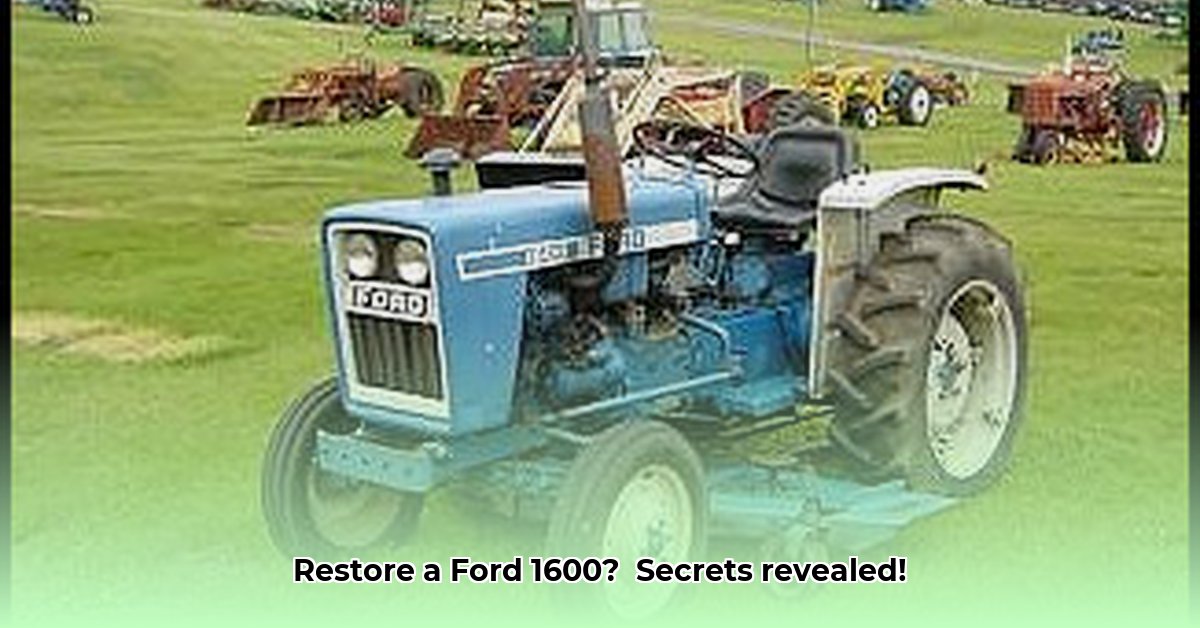
The Ford 1600 tractor, a compact machine produced from 1976 to 1979 by Shibaura Manufacturing Company in Japan for Ford, holds a unique place in the world of vintage tractors. Its simple yet robust design, coupled with surprisingly good parts availability, makes it a popular choice for restoration projects and small-scale farming. This guide provides a comprehensive overview of the Ford 1600, encompassing its history, mechanical details, restoration procedures, and ongoing maintenance. For more information on similar models, check out this useful resource.
Getting to Know Your Ford 1600
Before embarking on a restoration, understanding your Ford 1600 is crucial. Imagine a compact machine powered by a 1.3-liter, two-cylinder diesel engine. While not a powerhouse (approximately 23 PTO horsepower), its nine-speed gearbox offers surprising versatility. Its compact size excels in navigating tight spaces, and it's frequently equipped with mid-mount mower decks or front-end loaders, enhancing its functionality. Did you know that its compact design made it ideal for smaller farms or hobbyists? This versatility contributed to its long-term popularity.
Assessing Your Ford 1600: A Step-by-Step Approach
Restoring a tractor is a journey; take it step-by-step.
Visual Inspection: Begin with a thorough visual examination. Note any rust, dents, missing parts, or significant damage. Photography is invaluable for record-keeping.
Mechanical Checkup: This involves hands-on assessment. Check engine compression (a measure of engine health), oil and coolant levels, and test the transmission, PTO (power take-off – the system that powers attachments), and hydraulics. Addressing major mechanical issues early saves time and money.
Parts Inventory: Create a detailed list of necessary parts. This aids budgeting and efficient sourcing. Surprisingly, many Ford 1600 parts remain available.
Prioritizing Repairs: Determine which repairs are essential and which can wait. Focus on safety features and core functionality first.
Record Keeping: Maintain a detailed log of all procedures. This is indispensable for troubleshooting and future reference.
The Great Parts Hunt: Finding What You Need
Finding parts for a vintage tractor can be challenging, but the Ford 1600 boasts better parts availability than many similar models. Online tractor forums are valuable resources; experienced enthusiasts often direct newcomers to reliable suppliers. Specialty classic tractor parts suppliers, and even salvage yards (which may offer unique bargains), are additional avenues to explore. Engaging with online tractor communities fosters a supportive network of enthusiasts who share knowledge and experiences.
Restoration: A Rewarding Journey
Restoring a Ford 1600 is a labor of love, offering a connection to agricultural history. Remember, it's a marathon, not a sprint. Complex repairs, such as a complete engine rebuild, might require professional assistance – and that's perfectly acceptable.
Maintaining Your Ford 1600: Preventative Care
Regular maintenance is crucial for long-term reliability. This includes regular oil changes, filter replacements, and consistent checks of all vital fluids. Preventative maintenance is cost-effective in the long run, ensuring your Ford 1600 remains a reliable workhorse. Do you know the recommended oil change interval for your Ford 1600's engine? (Consult your service manual.)
Ford 1600: Weighing the Pros and Cons
Every machine has its strengths and weaknesses. The Ford 1600 is no exception.
| Pros | Cons |
|---|---|
| Simple design, relatively easy to maintain | Lower horsepower compared to modern tractors |
| Accessible parts | Increased susceptibility to age and wear-related issues |
| Compact and maneuverable | Basic features; lacks modern technological advancements |
| Generally lower purchase price than newer models | Requires more frequent maintenance than modern tractors |
Is a Ford 1600 Right for You?
The Ford 1600 offers a balance of simplicity, practicality, and historical appeal. It isn't ideal for large-scale operations demanding high horsepower. However, for those seeking an affordable restoration project or a manageable tractor for smaller tasks, the Ford 1600 presents a compelling option. Its enduring popularity reflects its continued value proposition.
How to Restore a Ford 1600 Compact Utility Tractor: A Detailed Guide
This section details the practical steps involved in restoring a Ford 1600. Remember, safety precautions are paramount throughout the restoration process.
Understanding Your Ford 1600: A Historical Perspective
Before starting, appreciate the Ford 1600's historical context. This adds depth to the restoration process. Knowing your tractor's manufacturing year can guide your approach.
Assessing the Condition: A Thorough Inspection
A comprehensive inspection is vital. Evaluate the exterior, engine, transmission, and hydraulic systems, noting any damage, wear, or missing parts. Thorough documentation (including photographs) is crucial.
Fluid Systems: The Lifeblood of Your Tractor
Proper fluid management is critical. Inaccurate information on fluid type and capacity abounds online. Always consult your service manual. Note: Cross-contamination between fluid systems can be catastrophic!
Fluid System Maintenance (Step-by-Step):
- Drain: Carefully drain fluids from each system into labeled containers.
- Clean: Thoroughly clean reservoirs and surrounding areas.
- Inspect: Check for leaks, corrosion, or damage.
- Refill: Use the correct fluid type and fill to the specified level (per your service manual).
- Test: Run the tractor and check for leaks or unusual operation. A correctly functioning engine is crucial before moving on to the other systems.
Sourcing Parts: A Systematic Approach
Finding parts for the Ford 1600 requires diligence. Online marketplaces, classic tractor parts suppliers, and salvage yards are all potential sources. Persistence is key!
Mechanical Restoration: A Detailed Breakdown
The extent of mechanical restoration depends on the tractor's condition. This may include:
- Engine Overhaul: Clean, inspect, and replace worn engine components.
- Transmission Repair: Address any damaged transmission components to ensure smooth shifting.
- Hydraulic System Repair: Inspect hoses, cylinders, and other hydraulic parts for leaks or damage. Repair or replace as needed.
- Electrical System Inspection: Examine wiring, battery, and starter.
- Bodywork Repair: Address any rust and repaint the tractor if necessary. Consider professional assistance for complex repairs.
Reassembly and Testing: The Final Stages
After restoration, carefully reassemble the tractor following your service manual precisely. Test all systems thoroughly before operation.
Finishing Touches and Documentation
Complete the restoration with cosmetic details like a final paint job. Remember to document your entire restoration journey—it's a valuable record of your efforts.